#Old Testament History
Text
A Parable for Our Times
A Summary of Old Testament History in a Parable
The Parable of the Unfaithful Wife
A husband betrothed a wife in a covenant of faithfulness. He bound himself to his wife and swore to love her, protect her, to never forsake her or abandon her for another. His bride made vows to him as well and bound herself to be faithful. She promised to respect him and follow him and to obey his leadership of…

View On WordPress
#A Parable for Our Times#Ancient israel#Old Testament History#Parables#Parables for a Sleeping Church
0 notes
Text

Abraham's sacrifice of Isaac is halted by an angel. Fresco in St. Sofia Cathedral, Kyiv, Ukraine, painted ca. 1000.
#art#art history#Middle Ages#medieval#medieval art#Ukraine#Ukrainian art#religious art#Biblical art#Christian art#Sacrifice of Isaac#Old Testament#Hebrew Bible#Book of Genesis#fresco#Orthodox Christianity#Eastern Orthodox
263 notes
·
View notes
Text

Moses and Joshua in the Tabernacle by James Tissot
#ark of the covenant#moses#joshua#art#james tissot#tabernacle#old testament#israelites#jewish#religious art#religion#religious#history#middle east#ark#christianity#bowing#biblical#bible#sacred#relic#tent#god#seraphim#seraphims#christian
183 notes
·
View notes
Text
History speaks for itself.



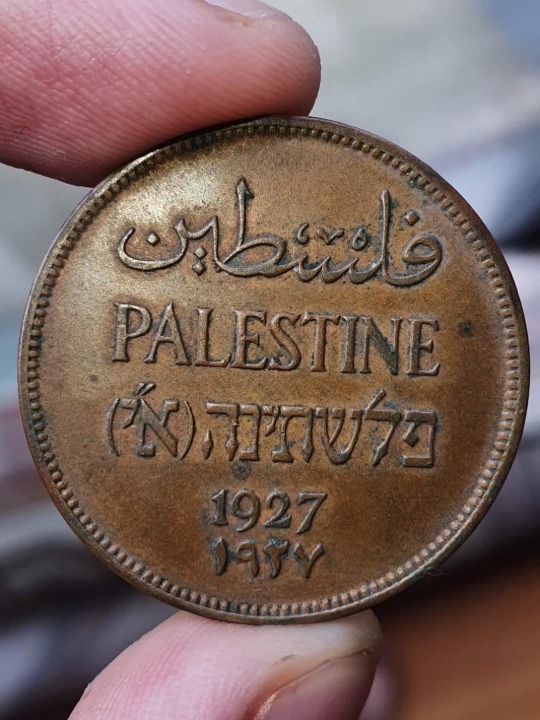

#history#truth#politics#palestine#facts#old maps#maps#books#holy land#bible#old testament#do some research#researchers#research#israel
89 notes
·
View notes
Text
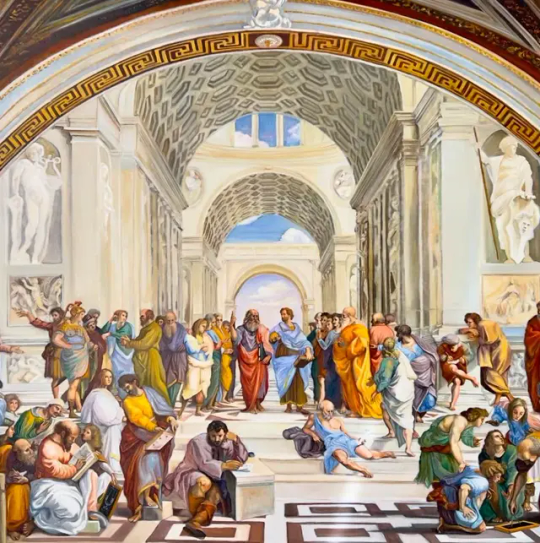
#art#fanart#the school of athens#renaissance#oil painting#handmade#oil on canvas#reproduction#art blog#classical art#artwork#painting#art history#Raphael#Raffaello Sanzio#religious art#Biblical art#Christian art#Christianity#Old Testament#Hebrew Bible#Ezekiel#Book of Ezekiel#Renaissance#Renaissance art#Italian Renaissance#High Renaissance#Cinquecento#Italian art#16th century art
24 notes
·
View notes
Text

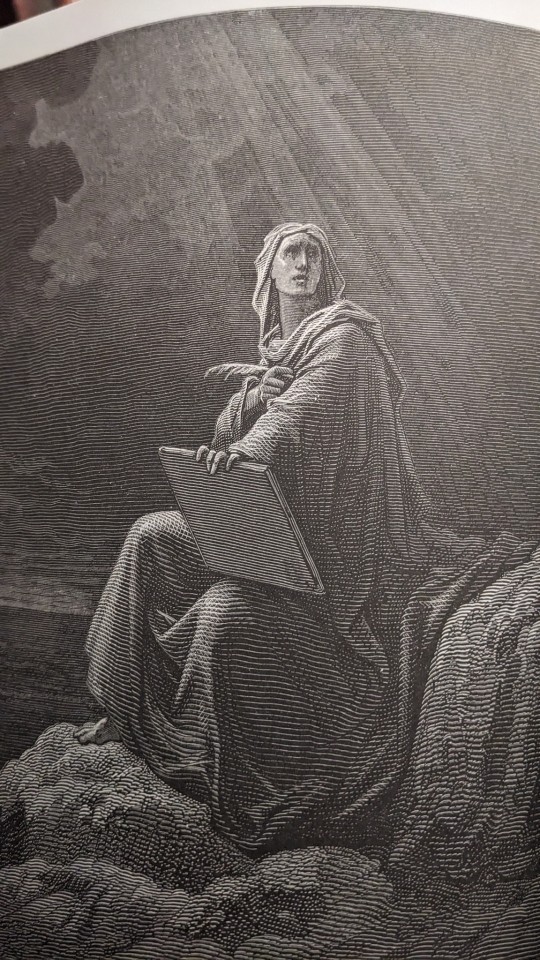

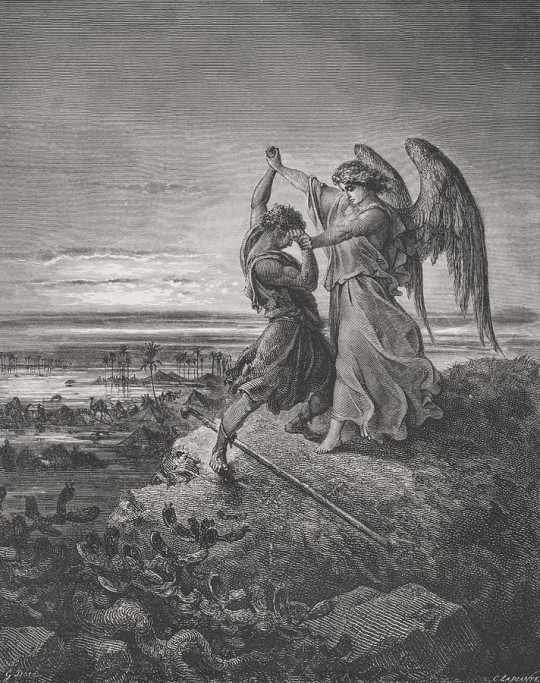
Doré's bible
#gustave doré#biblical art#the bible#old testament#new testament#biblical illustrations#art history#historical art#Victorian art#french art#classic lit
21 notes
·
View notes
Text
King Solomon, a key figure from the Old Testament, was famed for his immense riches. For millennia the source of his wealth was a mystery, but not anymore.
23 notes
·
View notes
Text
"And God so loved his people that he led them to the only place in the Middle East without water or oil. And there was much whining." -- Old Testment, Book 12, Page 302
7 notes
·
View notes
Text
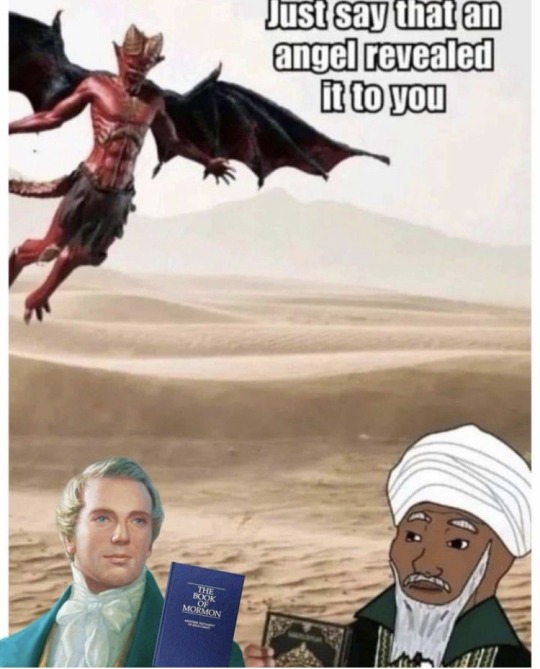
I’ve always believed Mormonism and Islam are pure evil and don’t even get me started on democracy
#Islam#mormon#mormonism#allah#anti Islam#christianity#old testament#history#heritage#paganism#pagan#lucifer
8 notes
·
View notes
Text

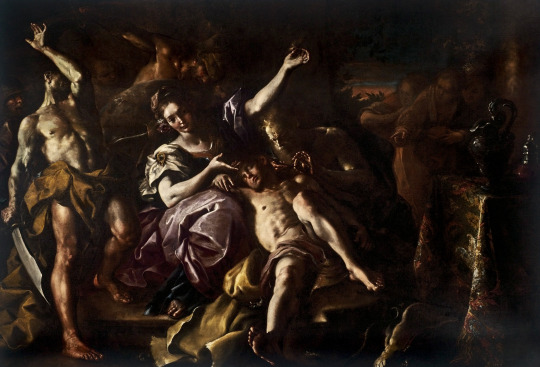
Giaele e Sisara and Sansone e Dalila by Bartolomeo Guidobono

These canvases by Bartolomeo Guidobono (Savona, 1654 - Turin, 1709) are the most recent acquisitions of the National Gallery of Liguria in Genoa. The monumental pieces depict two biblical scenes from the Old Testament. They most likely belonged to the Spinola family. After the Spinola di Pelliceria palace was donated and became the modern National Gallery of Liguria, the works were found to have been directly connected to the family's inventories and were likely commissioned by one of its members.
Guidobono was one of the most fascinating artists of the late 17th century Genoa. Until recently, there were no pieces by this painter at the National Gallery but a generous donation gifted the canvases to the museum. The pieces were published by an art historian Ezia Gavazza, specialist in seventeenth-century Genoese art.
#༺���༻ 𝕮𝔞𝔫𝔦𝔰 𝕸𝔞𝔧𝔬𝔯 ༺☆༻#༺⚚༻ 𝕲𝔞𝔩𝔩𝔢𝔯𝔦𝔞 ༺⚚༻#art#art history#italian art#genoese art#biblical art#old testament#Bartolomeo Guidobono
12 notes
·
View notes
Text







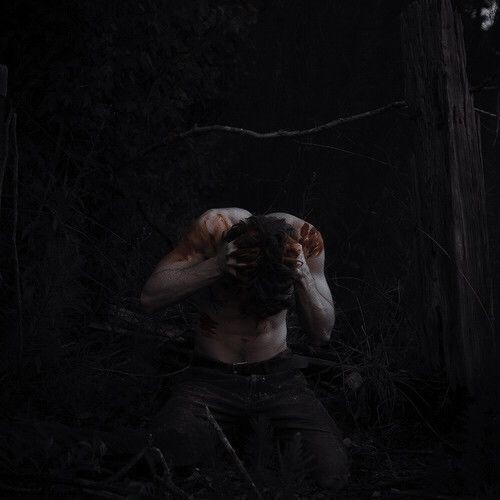


Baal/Bael/Ba'al = It is a title meaning "lord" or "master", There were many local Baals. The greatest, known as the “Great Baal”, is Son of the Father of the Gods, El, and Brother of the God of the seas and rivers, Yam-Nahar. Baal, known as “Knight of the Clouds”, is a God of fertility who represents the beneficial aspects of water such as rain. His lightning and thunder represent his Power, and the fertile land his beneficence.
#history#Baal#demon#God#God of agriculture#God of fertility#god of storms#god of fertility#weather god#God of weather#canaanite mythology#Phoenician#Biblical god#Pagan#fallen angel#Demon king#Biblical#old testament#Bible#Mythology#Phoenician mythology#canaanite religion#Canaanite
36 notes
·
View notes
Text
John 1:43-51
'Come and see’ replied Philip

The Martyrdom of Saint Bartholomew,
Painted by Jusepe de Ribera (1591 - 1652),
Painted in 1634, Oil on canvas
@ National Gallery of Art, Washington
Gospel Reading
After Jesus had decided to leave for Galilee, he met Philip and said, ‘Follow me.’ Philip came from the same town, Bethsaida, as Andrew and Peter. Philip found Nathanael and said to him, ‘We have found the one Moses wrote about in the Law, the one about whom the prophets wrote: he is Jesus son of Joseph, from Nazareth.’ ‘From Nazareth?’ said Nathanael ‘Can anything good come from that place?’ ‘Come and see’ replied Philip. When Jesus saw Nathanael coming he said of him, ‘There is an Israelite who deserves the name, incapable of deceit.’ ‘How do you know me?’ said Nathanael. ‘Before Philip came to call you,’ said Jesus ‘I saw you under the fig tree.’ Nathanael answered, ‘Rabbi, you are the Son of God, you are the King of Israel.’ Jesus replied, ‘You believe that just because I said: I saw you under the fig tree. You will see greater things than that.’ And then he added ‘I tell you most solemnly, you will see heaven laid open and, above the Son of Man, the angels of God ascending and descending.’
Reflection on the painting
Have you ever found yourself responding negatively to a suggestion of someone and then thinking further about it and having a change of mind and heart? I certainly have. Someone makes a suggestion as regards to parish life for example, and initially I respond with maybe little enthusiasm. I can only see the downsides, the problems, the complications, the demands it might make on time, etc... Then over time, I begin to see the suggestion in a different light. The words that that person spoke still linger in my mind and I mull it over. Then I come around to seeing that maybe there is something very worthwhile here after all.
That is exactly what happened to Nathaniel. Philip came up to him to share his enthusiasm for Jesus of Nazareth declaring that he and others had finally found the Messiah that the Jewish Scriptures had foretold. Nathanael’s initial response was dismissive, ‘From Nazareth? Can anything good come from there?’ We can indeed all be prone to dismissing people on the basis of where they are from or where they were brought up or their social background or even the colour of their skin or whatever. However, thanks to the gentle persistence of Philip, ‘Come and see’, Nathanael came to see Jesus and did change his mind! In fact he completely changed, as he gets on declaring ‘You are the Son of God, you are the King of Israel’. Jesus then responds that he hasn't seen anything yet!
The next time we meet Nathanael in this Gospel of John, he is to be among the group of disciples who went back fishing after the crucifixion of Jesus, to whom the risen Lord appeared. Nathanael did indeed see greater things...
When it comes to our relationship with the Lord, where we begin is not so important, because the Lord can always move us on, as long as we are open to being led by him.
Most Bible scholars believe Nathanael and Bartholomew were the same apostles. Our painting by Ribera is a profoundly moving work portraying the apostle's final moments before he is to be flayed alive. His body seemingly bursts through the surface of the canvas. His outstretched arms embrace a mystical light that illuminates his flesh. His piercing eyes, open mouth, and petitioning left hand convey an intense communion with the divine. He was a man who wasn't afraid to change his mind, even to the point of dying...
Article by Father Patrick van der Vorst
#biblical#christ#christian blog#glorytogod#bible fandom#bible reading#bible scripture#biblical art#christian doctrine#jesus#holy bible#holy spirit#holy trinity#Holy#bible study#bible verse#art history#religious art#old art#new testament#faith in jesus#bible lesson#john the baptist#artwork#godly wisdom#godly living#gospel#gospel truth#gospel message#faith in god
7 notes
·
View notes
Text
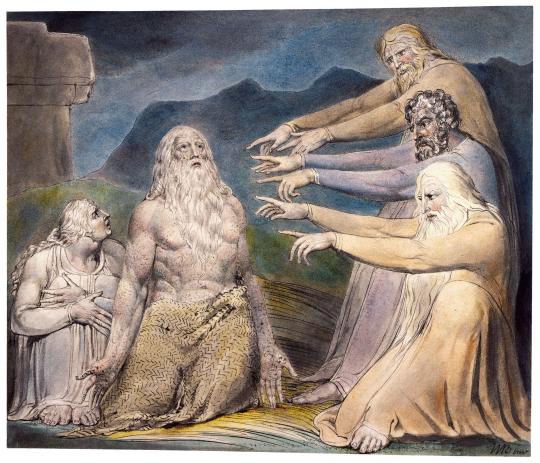
Job Rebuked by His Friends, William Blake, 1805
#art#art history#William Blake#religious art#Biblical art#Christian art#Christianity#Old Testament#Hebrew Bible#Book of Job#wisdom literature#Romanticism#Romantic art#English Romanticism#British art#English art#19th century art#pen and ink#watercolor#Morgan Library and Museum
863 notes
·
View notes
Text

"Das Hohelied Salomos" (№11)
by Egon Tschirch
Tempera on Cardboard, 1923.
Kunstmuseum Ahrenshoop.

Tschirch's Das Hohelied Salomos History:
Song of Songs is a painting cycle by Egon Tschirch comprising 19 sheets and 13 studies. Shown above is the 11th sheet.
Initially, Tschirch worked on the prompt Song of Songs in 1913, but as we all know, the Great War was going on, which interrupted the artist's process since he had to partake in the warfare. In 1923, Tachirch's exhibit debuted at the Kulturhistorische Museum, and because of high praise, it was presented at the Staatliches Museum Schwerin the following year.
Tschirch later gave the works to a painter friend for private ownership, which were then inherited after the friend's death in 1928 and left in a Berlin cellar near Kurfürstendamm to be wholly forgotten. However, the art was excavated from the basement and discarded in 2008 until found by a doctor in 2015 while researching the artist. Upon the discovery, the doctor allowed the works to be brought back to public display.

Song of Songs History:
שִׁיר הַשִּׁירִים in biblical Hebrew, the Song of Songs is a series of erotic poems found in the Tanakh (one of the five megillot parts in the Ketuvim section). The texts explores two lovers celebrating their desire and intimacy.
Read during the Sabbath of Passover, the poems are interpreted differently depending on the biblical religion, but in the end, it comes down to two allegories: 1) God's relationship with Israel, 2) Jesus' relationship with his bride (the bride being a metaphor for the church).
However, the scroll does not need to be attributed strictly to a religious basis to be appreciated, as it can be seen as a commemoration of human love, both involving the complexities and the beauty of such natural emotion.

#art#painting#tempera#tempera painting#cardboard#history#artwork#1920s#biblical#song of songs#love#judaism#christianity#Egon Tschirch#German#German art#old testament#tanakh#biblical art#biblical scripture#expressionism#expressionist#expressionist painting#expressionist art#1913#1923
9 notes
·
View notes
Text
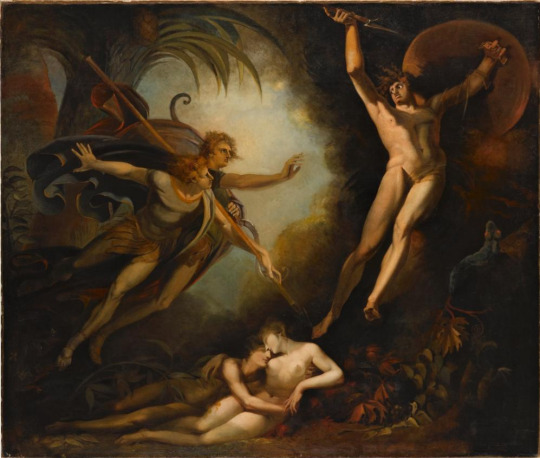
Henry Fuseli (1741-1825)
"Satan Touched by Ithuriel's Spear" (1779)
Romanticism
The painting depicts a scene from John Milton's "Paradise Lost" in which Ithuriel is one of two angels (the other being Zephon) charged by the archangel Gabriel to go in search of Satan, who is loose in the Garden of Eden. They find him lurking, in the shape of a toad, close to the ear of the sleeping Eve, attempting to corrupt her thoughts. Ithuriel touches Satan withhttps://en.wikipedia.org/wiki/Ithuriel his spear, causing him to instantly resume his true form:
Him thus intent Ithuriel with his spear
Touched lightly; for no falshood [sic] can endure
Touch of celestial temper, but returns
Of force to its own likeness: Up he starts
Discovered and surprised.
The angels then compel Satan to return with them to Gabriel.
#paintings#art#artwork#literary painting#religious painting#henry fuseli#romanticism#romantic movement#swiss artist#english literature#paradise lost#history#angels#satan#adam and eve#male figure#female figure#christianity#bible#old testament#1770s#late 1700s#late 18th century
120 notes
·
View notes
Text
I have a question for anyone Jewish or historians or Egyptian or anyone of that like;
I don't know enough about ancient Egypt and I don't know enough about the Old Testament. But I read that slaves definitely were not the people who actually built the pyramids in terms of heavy lifting. Those were skilled and selected workers as the job was far to important to be put "in the hands of slaves" or whatever. I read this somewhere but is this correct?
So if that's right; why do movies about Moses always show the slaves as building the Egyptian structures? Is it because only the pyramids were considered "too important"? Is it a visual metaphor for Egyptian royalty building on the backs of slave to better communicate this visually in a film although its not historically accurate at all? Does it actually say in relative certainty what slavery as described in the old testament entailed to any degree? is it because it was done in "The Ten Commandments" and now other movies kind of just do it too because it worked so well as a visual in that film?
I just never realised this before when watching Prince of Egypt but I know almost nothing about Egyptology so I'm unsure if I'm just being very confused here. But I've seen enough other bullshit historical movies to know not to take a film's depiction of history as accurate unless I do the research or get told otherwise by actual historians. (see: Braveheart/1492/The Patriot/Apocalypto/Basically anything made by Mel Gibson)
102 notes
·
View notes